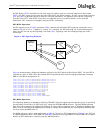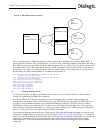
145
Dialogic
®
SS7G2x Signaling Server SGW Mode User Manual Issue 4
On Signaling Gateway 2, configure the IP addresses as follows and restart:
CNSYS:IPADDR=194.192.185.12,IPADDR2=194.192.185.12;
MNRSI;
On Signaling Gateway 2, configure the link sets as follows:
C7LSI:LS=1,OPC=2,DPC=1,LSSIZE=2,SS7MD=ITU14,NI=2,NC=1;
C7LSI:LS=2,OPC=2,DPC=2,LSSIZE=2,SS7MD=ITU14,NI=2,NC=1;
On Signaling Gateway 2, configure the SIGTRAN link as follows:
SNSLI:SNLINK=1,SNTYPE=M2PA,IPADDR=194.192.185.11,
IPADDR2=192.195.185.11,END=C;
On Signaling Gateway 2, configure the signaling links as follows:
C7SLI:C7LINK=1,EQU=1-1,TS=1-1-1,LS=1,SLC=1;
C7SLI:C7LINK=2,SNLINK=1,LS=2,SLC=0;
On Signaling Gateway 2, configure the SS7 routes as follows:
C7RTI:C7RT=1,DPC=1,LS1=1,LS2=2,NC=1,LABEL=SEP1;
C7RTI:C7RT=2,LS1=2,DPC=2,NC=1,LABEL=INTERLINK;
Linkset 1 is configured for both Signaling Gateways and has a destination point code of the SS7 switch.
Linkset 2 is a special linkset that has the same OPC and DPC. It is used to route messages destined for CICs
on the partner Signaling Gateway.
C7 route 1 is used to route calls from the Signaling Gateways to the SS7 switch, if LS1 is not available, the
signaling is routed via the partner Signaling Gateway using LS2. This is the C7 route assigned to circuit
groups.
7.6.3 Multihoming
An inherent property of the SCTP layer on the Signaling Gateway that is used in SIGTRAN Signaling (for
example, SS7 over M2PA) is that it supports IP multihoming. IP multihoming allows the SIGTRAN signaling
link SCTP association to be configured to communicate with multiple IP addresses in an active/standby
relationship. Multihoming offers a SIGTRAN signaling link significantly greater resilience since the link can be
configured with multiple IP addresses to operate over separate Ethernet ports within wholly separate IP
networks. IP ports and local IP addresses on the Signaling Gateway may be configured using the CNSYS
command (see page 57). SIGTRAN links may be configured to communicate with multiple remote IP
addresses using the SNSLI command (see page 120).


















